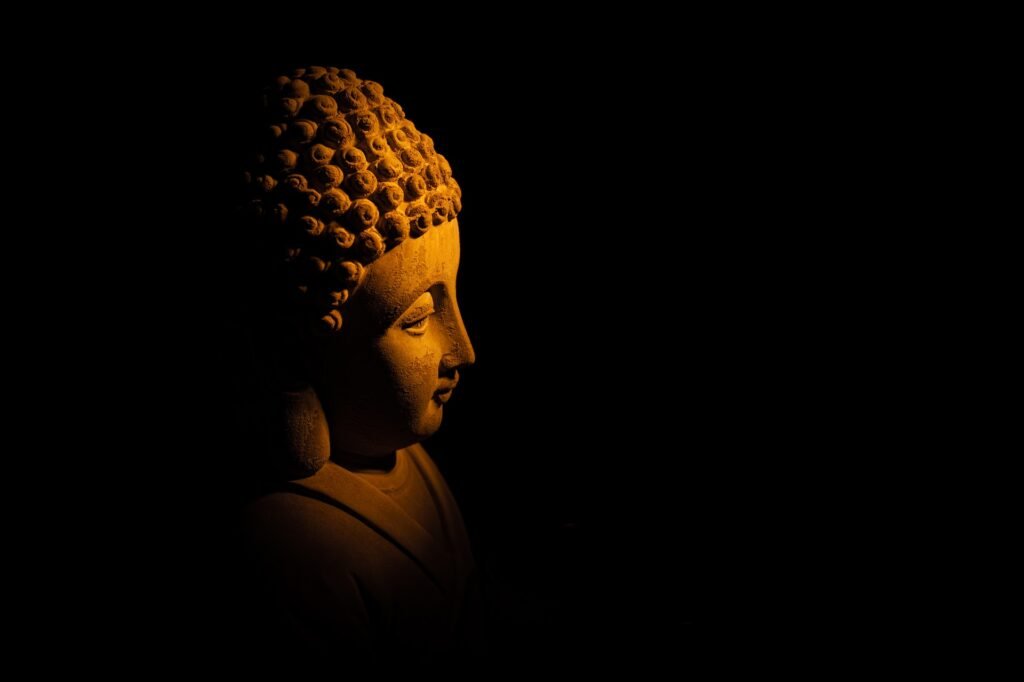
“All that is dear to me and everyone I love are of the nature to change. There is no way to escape being separated from them.”
from the Five Remembrances
Happiness and Buddhist Philosophy
We all want to be happy, but what does happiness mean? A bigger house, a faster car, a devoted partner, more beer, an open floor plan, a bigger TV, whiter teeth, the latest smartphone without that troublesome bezel, another baby, a Harley, a companion for my pet, a horse, a gold plated toilet, more money, and on and on and on. We’ve all been there, but how many of us reflect upon how well this thinking has worked out? Did obtaining these things make us happy? Did the happiness experienced by these acquisitions meet our original expectations? Has that happiness endured and supplanted all the other cravings? Probably no, no, and no. And that is because most of us go through life unaware of the Buddhist Remembrance quoted above, which may seem depressing at first but offers us a path to enduring happiness. Let’s see how that is possible.
In the context of Buddhism, happiness isn’t just a fleeting feeling of pleasure or excitement. Instead, it’s a deep sense of contentment and well-being that arises from within and survives the changing nature of our reality. It’s a state of being that transcends the ups and downs of life and is not dependent on external circumstances. This happiness is rooted in compassion, wisdom, and interconnectedness with our environment and all beings.
In contrast, our commonly held view of happiness depends on external factors (stuff, people, weather, investment returns, health, etc.) that are mostly outside of our control. We believe that once we have the perfect job, the perfect relationship, or the perfect set of material possessions, we will finally be happy. However, this idea is fundamentally flawed because it relies on the assumption that these things will meet our unrealistic expectations and last forever. The truth is that external factors rarely meet our expectations and can be lost or taken away from us at any time.
Expectations Dashed
For example, we buy the perfect new car, breathe in that wonderful new-car aroma and drive around town proudly. We’re so happy! But how long does that happiness last? When parked one day, the car next to ours dings the door, and suddenly the new car is not so perfect anymore. Then, the vehicle requires maintenance, gets old, and eventually breaks down and becomes unreliable.
Similarly, we might get our dream house with the perfect view – a view we soon become accustomed to and take for granted. Eventually, our neighbor’s dog fouls the pristine lawn, the roof leaks, the golden toilet clogs, and the air conditioner fails. Happy days!
Relationships, too, are susceptible to the fleeting nature of happiness. Friends and loved ones come and go, and the ups and downs of life challenge even the most robust relationships.
Does this mean Buddhism wants us to abandon our friends, family, and material desires? While it may seem that way on the surface, Buddha has something else in mind – a way of living that he called the Middle Way – to enjoy our pleasures mindfully and in moderation recognizing their impermanence and avoiding becoming overly attached to them. By putting our desires into perspective and finding balance, we can avoid the extremes of both indulgence and denial and achieve a more peaceful and contented state of being.
The Middle Way is why the Buddhist view of happiness is so powerful – it emphasizes the importance of finding lasting contentment and well-being within ourselves rather than relying exclusively on external factors for happiness.
The Buddha
To truly understand the concept of happiness in Buddhism, it is helpful to take a closer look at the history of the Buddha himself. Born Siddhartha Gautama in ancient India, he was raised in luxury as a prince but became disillusioned with the empty pleasures of his privileged life. Seeking answers to the fundamental questions of existence, he left his comfortable life behind and embarked on a spiritual journey of self-discovery.
After years of rigorous study and contemplation, the Buddha attained enlightenment, which gave him a clear and direct perception of the workings of our minds and how our minds relate to the environment. Through this profound understanding, he recognized that suffering and discontentment are inherent conditions in the human experience. He also realized that it was possible to overcome them. This recognition led Buddha to teach his followers the Four Noble Truths. These teachings emphasize the nature of suffering, its causes, its cessation, and a way of living that cultivates a deeper understanding of ourselves and our relationship with our world. Through this, we achieve lasting happiness that transcends the cycle of suffering.
Let’s look at this ancient wisdom and see how it might bring us lasting happiness today.
The First Noble Truth
The First Noble Truth says there is suffering. Buddhism understands that feelings of dissatisfaction and suffering, known as “dukkha” in Sanskrit, result from how we view our lives. Buddha recognized that most of us go through life pretending – we pretend that we will never grow old, that we will never get sick, and that we will never die. We may acknowledge that these fundamental facts of life are true, but we live as if they are not. We spend most of our time in a dream world characterized by magical thinking. And the reason is reality scares us. It scares us because aging, sickness, loss, and death are inevitable, universal experiences we cannot escape. This fear leads to an underlying sense of dissatisfaction, and this is precisely what the word “dukkha” means.
Buddha identified three different forms of “dukkha“:
- Ordinary physical and mental pain.
- Suffering is caused by change, which is the impermanent nature of everything, including life.
- Our failure to understand our relationship to our environment.
This third form of “dukkha,” understanding our relationship to our environment, is challenging for modern Westerners to accept outright, so let’s dig deeper.
Buddha’s teachings emphasize that the notion of a distinct and unchanging self is a misconception. Instead, our self is continually shaped by our connections and experiences with others and the world, making interdependence a fundamental aspect of our existence. The failure to recognize this interconnectedness leads to a sense of isolation and suffering. The concept of no-self is not a rejection of our individuality but rather an acceptance of our deep and inextricable link to all living beings.
So that is Truth One – acknowledge that dissatisfaction and suffering exist. Easy! Let’s move on.
The Second Noble Truth
The Second Noble Truth says there is a cause for this suffering. Buddhism teaches that attachment, seen as craving and aversion, is the primary cause of suffering. It maintains that our desires and dislikes, stemming from our attachment to specific experiences and avoidance of others, impede happiness and lie at the core of our suffering. Let’s delve deeper into the rationale behind this belief.
Craving
In Buddhist teachings, craving arises from our attachments to people and things, to the idea that we need something external to ourselves to be happy or fulfilled. The reality of our existence is that it is constantly changing and that nothing and no one is permanent. Therefore, trying to hold onto anything or anyone will eventually fail. Attachment arises from our desire for things to be a certain way and our inability to accept when they are not. We refuse to recognize a fundamental Buddhist concept as true – “Whatever has the nature to arise also has the nature to cease.”
Craving takes many forms, such as the desire for sensory pleasures, material objects, pleasures of the mind, or even the longing for our continued existence, both now and perhaps after death. Attachment causes harm when we cling to these impermanent and constantly changing people, places, and things.
Attachment harms us further when we create a sense of imbalance in our lives by focusing all our energy and attention on one thing at the expense of all else. For instance, if we become overly attached to our work, we may neglect our health, relationships, or hobbies, leading to sickness, burnout, and dissatisfaction.
Buddha doesn’t mean we should abandon our friends and family to live an ascetic life devoid of all material goods. His point is instead that we should understand the nature of existence and approach things accordingly – an approach he called the Middle Way. As mentioned earlier, the Middle Way is a Buddhist concept that emphasizes finding a balance between extremes in life. It suggests avoiding both excessive indulgence and severe self-denial. Instead, the Middle Way promotes a moderate and mindful approach to life, which can lead to a state of equilibrium, contentment, and wisdom. The Buddha taught that conducting oneself according to the Middle Way brings lasting happiness by overcoming suffering and achieving enlightenment.
Aversion
According to Buddhist teachings, attachment to our preferences and expectations causes aversion or dislike for certain experiences. When we don’t get what we want or encounter something we don’t like, we experience discomfort that can be physical or mental and ranges from mild to extreme.
Aversion spends our limited psychological energy and causes us harm by creating negative emotions and reactions. When we experience aversion, we may feel angry, frustrated, anxious, or afraid, leading to mental and physical discomfort. Aversion also prevents us from accepting the present moment as it is, causing us to dwell on the past or worry about the future. The result is stress, anxiety, and depression. Additionally, aversion creates a sense of disconnection and separation from others and the world around us, leading to isolation and loneliness, not happiness.
When we react with aversion, we may engage in behavior that harms ourselves or others. For example, we may say or do hurtful things to someone we dislike or use addictive substances or behaviors to numb ourselves from uncomfortable emotions. These actions only reinforce our aversion and can create more suffering. In Buddhism, such harmful behavior is called “unskillful.”
Examples of unskillful behavior in Buddhism include acts of violence, dishonesty, greed, selfishness, and harmful mental states like anger, jealousy, and delusion. These actions create negative karma, a kind of energy thought to influence future experiences. While karma may feel strange to Westerners, consider how your behavior in a confrontation, for example, can impact subsequent events. If you meet an adversary with unskillful acts, the conflict will escalate. If, on the other hand, you respond with equanimity, the confrontation may cease without further consequence. This is karma.
The Second Noble Truth encourages us to recognize and understand our cravings and aversions and their role in our everyday experiences. By cultivating mindfulness and awareness through meditation, we can become more attuned to our thought patterns and learn to let negative emotions go.
So far, we have acknowledged that:
- suffering and dissatisfaction are part of life
- attachment in an ever-changing environment causes suffering
So how does this knowledge lead to happiness? Let’s move on to Truth Three.
The Third Noble Truth
The Third Noble Truth tells us that the way out of suffering is through the cessation of dukkha. The Fourth Noble Truth provides us with a step-by-step guide to getting this done.
To liberate ourselves from dukkha, we must relinquish the false beliefs and lack of knowledge that trigger craving and aversion, leading to suffering and discontentment. We can attain a more profound sense of happiness by acknowledging and understanding our cravings and aversions and choosing to let them go. To accomplish this, we cultivate the capacity to observe our mental processes more lucidly, and instead of giving in to them, we let go of them with kindness and understanding. Ultimately, the goal is to achieve a state of equanimity and freedom from suffering by recognizing the impermanent and interconnected nature of all things, which is what Truth Four will do.
The Fourth Noble Truth
The Fourth Noble Truth describes the steps to end our discontent and suffering. These steps are known as The Eightfold Path. Following this path cultivates mindfulness and ethical conduct through which we gradually overcome our aversions and attachment to fleeting pleasures and find a more profound, lasting sense of happiness.
The Eightfold Path consists of the following:
Ethical Conduct
Right Speech: Speaking truthfully and kindly and avoiding harmful speech.
Right Action: Acting in ethical and compassionate ways and avoiding harm to oneself and others.
Right Livelihood: Earning a living in a way that is ethical and does not cause harm.
Mental Discipline
Right Effort: Making a concerted effort to cultivate positive qualities such as mindfulness and compassion.
Right Mindfulness: Developing an awareness of the present moment without judgment or distraction.
Right Concentration: Cultivating the ability to focus the mind and develop deep states of concentration through meditation.
Wisdom
Right Understanding: Understanding the Four Noble Truths and the nature of reality.
Right View: Cultivating wholesome intentions, such as compassion and non-harm, and viewing existence from the perspective of the Four Noble Truths.
By following this path, we develop a deeper understanding of ourselves and our place in the world, cultivate ethical behavior and mental discipline, and find happiness that is not dependent on external factors. The path emphasizes mindfulness, compassion, and wisdom, enabling us to find peace and contentment amid life’s challenges and changes. Rather than trying to push away or deny difficult emotions, we learn to sit with them and observe them with a non-judgmental attitude. By following the Four Noble Truths, including the Eightfold Path, we achieve a more balanced and harmonious life that brings lasting happiness and a sense of balance and well-being.
Summary
The Buddhist concept of happiness differs from the commonly held view that happiness depends on external factors. Buddhism emphasizes that happiness arises from within, is not dependent on external circumstances, and survives the changing nature of reality. The Middle Way encourages mindfulness and moderation to avoid extremes of indulgence and denial, leading to a more peaceful and contented state of being. The Buddha’s teachings on the Four Noble Truths emphasize the nature of suffering, its causes, its cessation, and a way of living that cultivates a deeper understanding of the nature of reality, leading to happiness and transcending the cycle of suffering. Finding lasting happiness even in life’s challenges and changes is possible by cultivating mindfulness, compassion, and inner peace.
References
- Wells, Dyana. “The Four Noble Truths and Modern Life | Dyana Wells.” Accessed April 14, 2023. https://dyanawells.com/the-four-noble-truths-and-modern-life/
- “The Dharma: The Teachings of the Buddha.” Accessed March 30, 2023. https://pluralism.org/the-dharma-the-teachings-of-the-buddha.
- O’Brien, Barbara. “Why Do Buddhists Avoid Attachment?” Learn Religions, August 25, 2020, https://learnreligions.com/why-do-buddhists-avoid-attachment-449714.


